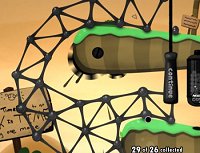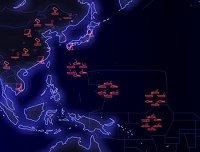 |
|
Digits & Dragons by Greg Allen |
March 2009
Independents' Day
One of the problems of years gone by is that titles are either big enough to fill store
shelves (though quality is a crapshoot), or they fail to reach that size and get relegated
either to the bargain bin or to random places on the internet (where quality is even
more of an unknown). For independent games and games without a huge publishing
force behind them, there were a lot fewer ways to bring titles to people's attention and
to have them fairly evaluated in the market.
With the rise of online distribution channels like Steam, Xbox Live Arcade, WiiWare,
PlaystationNetwork, and many others, that is changing. These large, common
marketplaces (and a myriad of smaller ones) now give smaller/self publishers much
deeper penetration into markets, opening up far more opportunities to get games seen,
reviewed, and purchased by gamers around the world.
Independent games are nothing new and many smaller publishers have survived since
the dawn of gaming, but what has seen huge improvement in the last few years is the
ease with which your average, casual gamer can get access to these titles. I, for one,
am a pretty avid gamer, but like many, I don't have unlimited time or money for
games and when I do decide to get one, I don't want it to be garbage. Prior to these
online marketplaces, I would rarely take a gamble on a title from a no-name publisher
unless it had received great word-of-mouth feedback, which meant that these
purchases were pretty rare. Now, all that has changed. I now buy a number of these
titles each year, not only because they tend to be cheaper ($15-$20 vs $50-$60 for a
AAA title), but also because they tend to innovate in ways simply not seen in major titles.
Sticky Situations
A recent example of the success of the online-only, marketplace-driven model is
World of Goo. WoG was released last year for the Wii and PC/Mac/Linux and took
off not by filling store shelves and heavy advertising, but by releasing a quality, non-bloated game through the right channels. With only two developers, 2DBoy created a
game that was innovative, fun, and quirky and then let it loose to communities. Pretty
soon, it got the attention it deserved in these marketplaces and began racking up the
awards and the sales.
The idea behind WoG is deceptively simple: for each level, get a certain number of
goos into a pipe. To do this, you will have to use the properties of the goos you are
given to create a stationary or moving structure that can get you to your goal. There
are a variety of different kinds of goos, ranging from the simple, one-time-use black
and red goos to the recyclable greens and the bomb-proof whites. Add in balloon
goos, bombs, wind, etc., and things start to get really interesting. While there are a lot
of variations, the majority of your time will be spent simply making stable
towers/structures with as few goos as possible - something I find surprisingly
satisfying.

Goo structures bend but careful, they also break!
|
Like any good physics game, the puzzles are their own reward and don't necessarily
need a story or context to be enjoyable. That's not to say having a story doesn't add to
the depth, though, and WoG succeeds not only in making fun puzzles but in really
feeling like a complete game thanks to a quirky tongue-in-cheek world that gives
meaning to your goo manipulations.
While pieces of the story are told in cut scenes, much of the context and humor comes
from signs spread around the levels that are penned by the mysterious "Sign Painter."
In these messages are not only hints to the levels but hints to what this world is all
about. The messages may not always make a ton of sense, but they do help you to
feel like you are not just solving cool puzzles, you are also saving this world!
Music to Get You Moving
Another independent success story is AudioSurf, a racing/rhythm game for the PC.
The basic premise is pretty simple: try to collect groups of the same colored blocks to
score as many points as possible before a song ends. What makes the game take off
is that each level is based on music of your choosing. Stick in a mellow CD or
choose a mellow mp3 from your hard drive and you will get a calm, easy track.
Select an intense song and the track will reflect this with far more blocks and speed.

If you like music and casual puzzle games, AudioSurf is a good fit.
|
Music visualization has been around for a while and is built in to iTunes and other
applications, but AudioSurf goes beyond just a passive representation of a song and
actually allows you to "play" through your favorite music. Your scores from the song
are then compared with others who have raced through those titles so you can see
how good you really are. I personally didn't love the game, but I think that is
probably because I am just not the right type of gamer rather than because this is a
poor game. If you love music and enjoy casual games, AudioSurf can be a blast.
Got Time?
Messing with structure in WoG is interesting and messing with rhythm in AudioSurf
is cool, but to really blow your mind, check out Braid, a side-scrolling platformer
based on messing with time. Released for the Xbox Live Arcade last year and
coming out for PC this soon, Braid is all about solving seemingly impossible puzzles
by altering the flow of time.
Braid is set up as a journey through multiple worlds, and each world has a twist on
altering time. In one, it may be that some pieces of the level are immune to your
turning back time. In others, your shadow will act out the path you just took after you
rewind time to go back to the start. Through all of them, you will be forced to think
about game and level strategy like you never have before.
Like most of these games, Braid isn't very long, but it makes up for the gameplay
length with a novel and fun approach that is lacking in many major titles. Not only is
the puzzle mechanic fascinating, but the story woven into the game is deeper than you
would expect.
Let's play Global Thermonuclear War
Defcon is a couple of years old but still deserves mention as a game that wouldn't
have had the success it did without a good online marketplace. Made by a small
group of developers, Defcon is pretty close to what you would expect the WarGames
simulators to play like.
The game takes place entirely on a pretty simple, chalkboard-esque map of the world
which gives an eerie aloofness to the horrific things happening to the Earth. The
games starts at Defcon Five with the world in relative peace as you start placing your
silos, air bases, naval fleets, and radar stations.

My fleet moves into place to defend the Eastern seas
|
As the clock ticks down to Defcon One the tension rises as you start moving subs and
planes into position and you start mapping out targets. By the time Defcon reaches
Level One, the ICMBs are flying, the fighters are battling for air superiority and cities
are being leveled.
A game with such simplistic graphics and drawn-out, strategic gameplay only appeals
to a small slice of gamers, yet thanks to its placement on Steam and great word of
mouth, Defcon has become moderately successful and gained quite a bit of notoriety.
It's certainly not a game to get giddy over (due to the nature of its content) but it is
pretty unique in its simple presentation and complex strategy.
None of these games are ones that will keep me busy for dozens of hours like Left 4
Dead, Team Fortress 2 or other best-of-breed AAA titles, but they are a refreshing
alternative and should certainly be part of a healthy gaming diet.